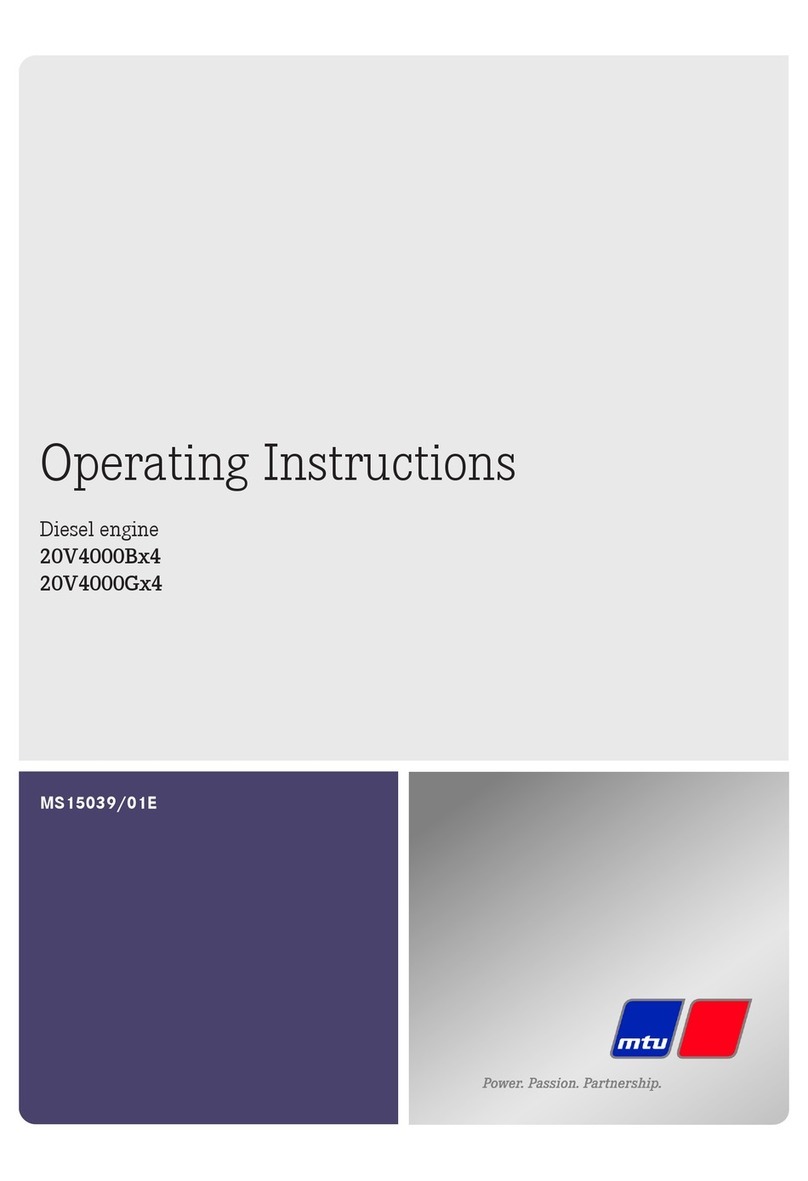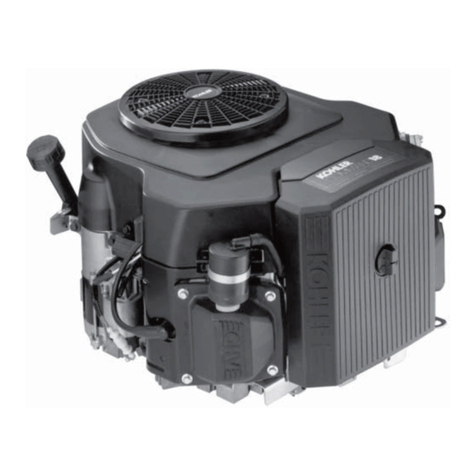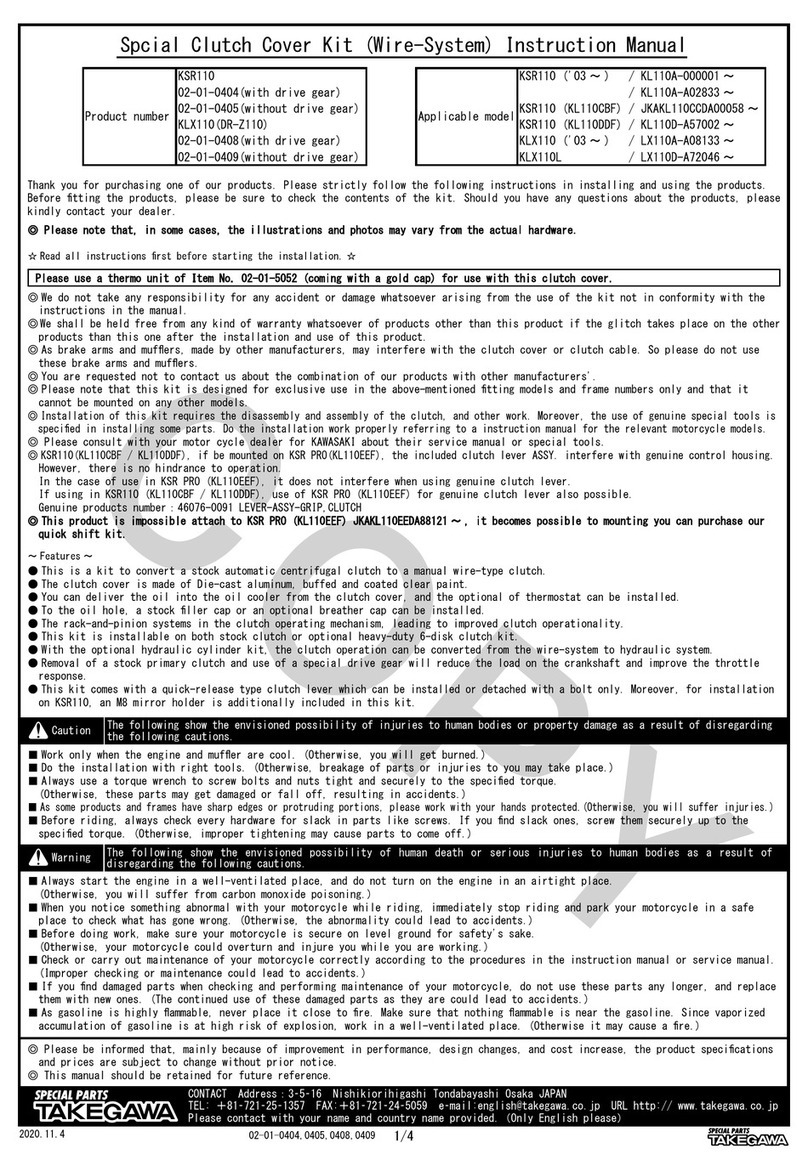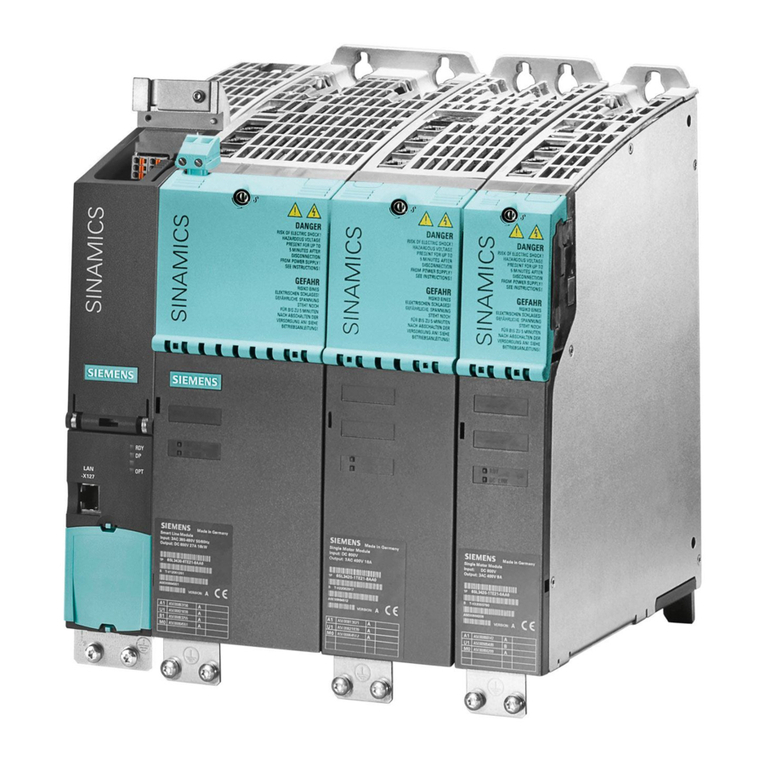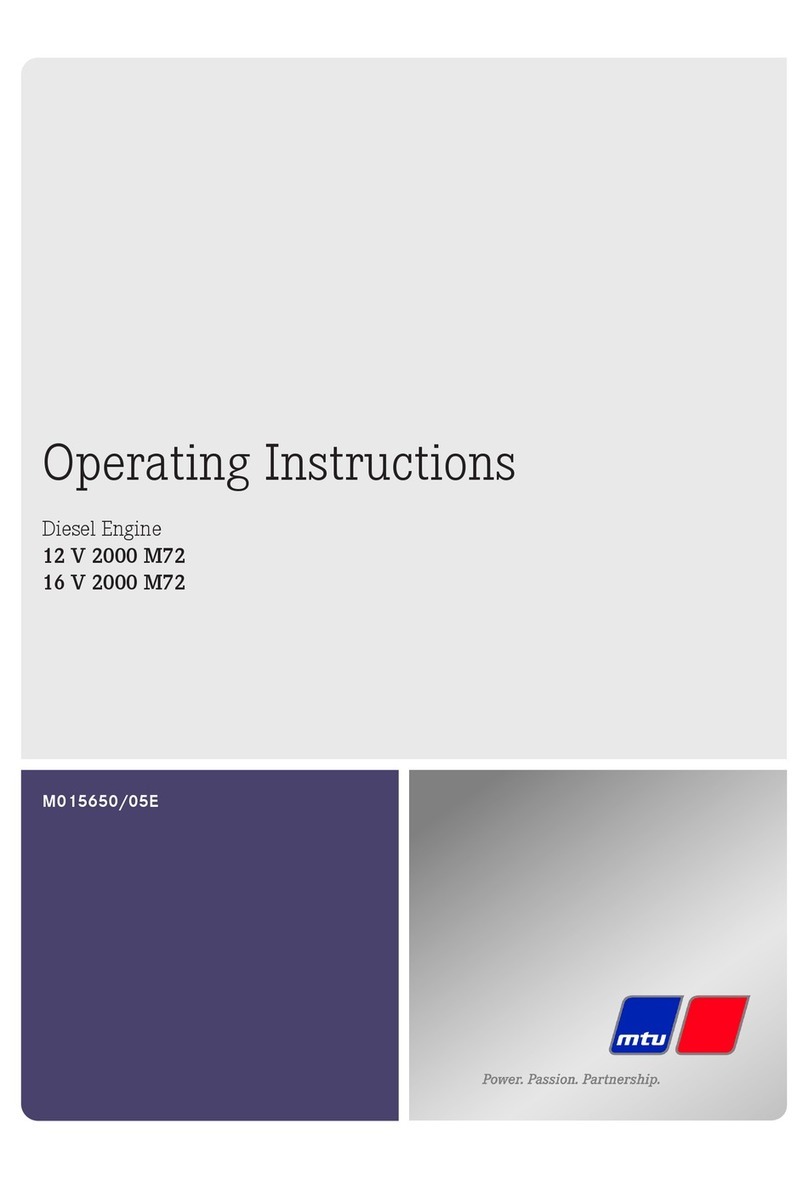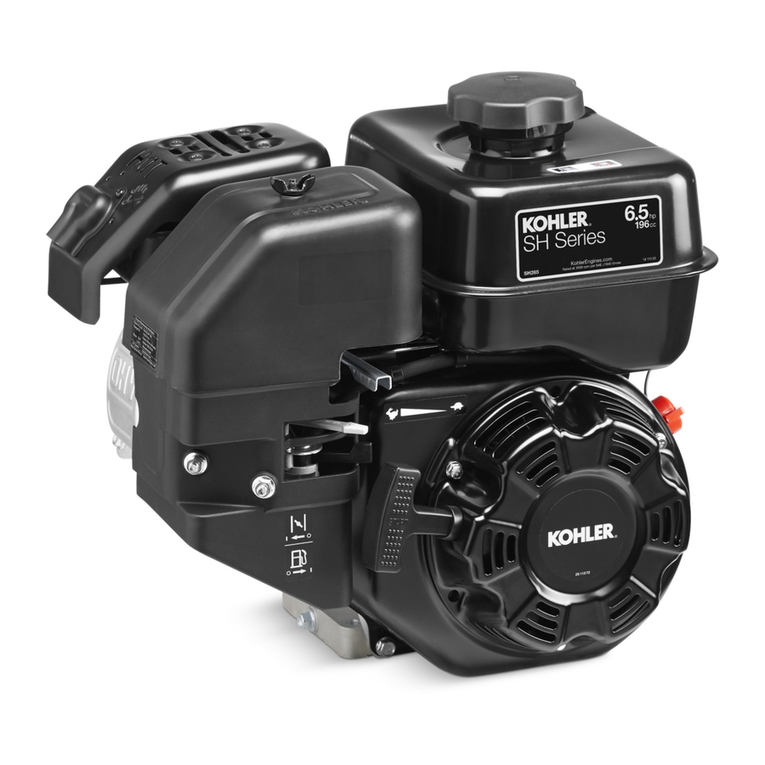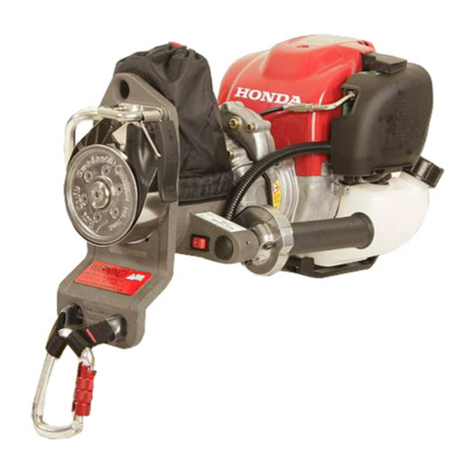Impco HHI User manual

2007-
2009
LPG
& Bi
2.0L
Service Manual
HHI
2009
Emission Certified
& Bi
-Fuel
System
2.0L
Engine
Service Manual
Revision A/June, 2009
Emission Certified
System
Service Manual

Table of Contents
General Information
................................
An overview
of this Service Manual
Maintenance
................................
General maintenance and maintenance interval information
LPG Fuel System
................................
An overview of the LPG fuel system and its components
LPG Fuel System Diagnosis
How to identify a general problem
LPG Symptom Diagnos
tics
How to correct a specific problem
Gasoline Fuel System
................................
An overview of the
Gasoline
Gasoline Fuel System Diagn
How to identify a general problem
Gasoline
Symptom Diagnostics
How to correct a specific problem
Electrical Section
................................
Diagnostic Scan Tool
................................
Using the DST for testing and trouble shooting
Wire Schematic
................................
Engine wiring schematic
Engine Wire Harness Repair
Repairing a wire harness on the vehicle
Diagnost
ic Trouble Codes (DTCs)
Application, schematic and DTC specific code information
Table of Contents
................................
................................
................................
of this Service Manual
................................
................................
................................
General maintenance and maintenance interval information
................................
................................
................................
An overview of the LPG fuel system and its components
LPG Fuel System Diagnosis
................................
................................
How to identify a general problem
tics
................................
................................
How to correct a specific problem
................................
................................
................................
Gasoline
fuel system (bi-fuel models only)
and its components
Gasoline Fuel System Diagn
osis................................
................................
How to identify a general problem
with the Gasoline fuel system bi-
fuel
Symptom Diagnostics
................................
................................
How to correct a specific problem
with the Gasoline fuel system (bi-
fuel model
................................
................................
................................
................................
................................
...........................
Using the DST for testing and trouble shooting
................................
................................
................................
Engine wiring schematic
Engine Wire Harness Repair
................................
................................
Repairing a wire harness on the vehicle
ic Trouble Codes (DTCs)
................................
................................
Application, schematic and DTC specific code information
................................
.....5
................................
............... 11
................................
....... 19
................................
..................... 29
................................
....................... 39
................................
55
and its components
................................
.............. 63
fuel
models only)
................................
............... 71
fuel model
s only)
................................
....... 85
...........................
87
................................
..... 121
................................
................ 125
................................
...... 129

Servicing the Fuel System
Step by step instructions on how
Definitions
................................
Definitions of phrases and acronyms used throughout this Service Manual
Tool Kit & Accessories
................................
Definitions of phrases and acronyms used throughout this Service Manual
Appendix
................................
Altitude vs. Barometric Pressure
Servicing the Fuel System
................................
................................
Step by step instructions on how
repair and/or replace fuel related c
omponents
................................
................................
................................
Definitions of phrases and acronyms used throughout this Service Manual
................................
................................
..............................
Definitions of phrases and acronyms used throughout this Service Manual
................................
................................
................................
Altitude vs. Barometric Pressure
& Ignition System Specifications
................................
........................ 457
omponents
................................
.................. 475
Definitions of phrases and acronyms used throughout this Service Manual
..............................
481
Definitions of phrases and acronyms used throughout this Service Manual
................................
.................... 483

4

5
General Information

GENERAL INFORMATION
6
INTRODUCTION
This service manual supplement has been
developed to provide the service technician
with the basic understanding of the IMPCO
certified fuel and emission systems for the
2.0L engine. This manual should be used in
conjunction with the base engine manual and
the OEM service manual when diagnosing
fuel or electrical problems.
HOW TO IDENTIFY THE ENGINE YEAR
The 2.0L engine blocks have been stamped
with a serial number. The number can be
found on the left side of the top edge of the
engine block near the exhaust manifold.
Engine Identification Number Table
SERVICING YOUR EMISSIONS
CERTIFIED ENGINE
Any maintenance and repair should be per-
formed by trained and experienced service
technicians. Proper tools and equipment
should be used to prevent injury to the servic-
ing technician and damage to the vehicle or
components. Service repairs should always
be performed in a safe environment and the
technician should always wear protective
clothing to prevent injury.
For parts or labor to be reimbursed under the
IMPCO Technologies Inc. emission warranty,
only work performed by IMPCO or OEM
trained technicians using only IMPCO speci-
fied parts will qualify for reimbursement.
Refer to the IMPCO Labor Time Guide for ad-
ditional information.
For parts or labor not reimbursed under war-
ranty, a repair shop or person of the owner’s
choosing may maintain, replace, or repair
emission-control devices and systems. It is
highly recommended that any replacement
parts used for maintenance or for the repair of
emission control systems be new OEM re-
placement parts. The use of other than
genuine IMPCO replacement parts may im-
pair the effectiveness of emission control
systems, therefore, the owner should assure
that such parts are warranted by their manu-
facturer to be equivalent to genuine IMPCO
OEM parts in performance and durability.
FUEL QUALITY
LPG
Note that LPG engines are designed to operate
on HD–5 or HD–10 specification LPG fuel. Fuel
other than HD–5 or HD–10 may cause harm to
the engine’s emission control system and a war-
ranty claim may be denied on this basis if
operators can readily find the proper fuel*.
Use of any other fuel may result in your engine no
longer operating in compliance with CARB or
EPA emissions requirements.
*Not Applicable in the state of California.

GENERAL INFORMATION
7
Gasoline
IMPCO recommends the use of name brand
high detergent gasoline. Gasoline is a mixture
of many different hydrocarbons, including ole-
fins, which are heavy, waxy compounds. Over
time, these deposits can build up and clog the
fuel injectors. The formation of these deposits
is a normal consequence of engine operation,
so detergents are added to high quality gaso-
line to help keep the injectors clean. The use
of low quality low detergent gasoline may
cause fuel injectors to fail. Fuel injector re-
placement or cleaning is expensive, and the
cleaning procedure requires special equip-
ment that may not be practical in the industrial
lift truck market. Speak with your fuel supplier
to verify that the fuel you are supplied con-
tains the necessary fuel additives to keep
your fuel system clean. IMPCO may deny
emissions related warranty claims due to the
use of low quality low detergent gasoline.
FUEL SYSTEM CAUTIONS
Do not smoke, carry lighted tobacco or
use a lighted flame of any type when
working on or near any fuel related
component. Highly flammable air-fuel
mixtures may be present and can be
ignited causing personal injury
Do not allow LPG to contact the skin.
LPG is stored in the fuel tank as a liq-
uid. When LPG contacts the
atmosphere, it immediately expands
into a gas, resulting in a refrigeration
effect that can cause severe burns to
the skin.
Do not allow LPG to accumulate in
areas below ground level such as in a
service pit or underground ventilation
systems. LPG is heavier than air and
can displace oxygen, creating a dan-
gerous condition
Do not make repairs to the LPG fuel
system if you are not familiar with or
trained to service LPG fuel system.
Contact the dealer who sold you the
vehicle to locate a repair facility with
trained technicians to repair your fuel
system
WARNINGS, CAUTIONS AND NOTES
This manual contains several different Warn-
ings, Cautions, and Notes that must be
observed to prevent personal injury and or
damage to the vehicle, the fuel system or
personal property.
A “WARNING“ is an advisement that by per-
forming a process or procedure listed in this
manual improperly may result in serious bodi-
ly injury, death and/or serious damage to the
vehicle or property.
Typical Warning Label:
Failure to heed instructions could re-
sult in death, injury, or property
damage.
A “CAUTION” label or statement is used when
it has been determine that by performing a
process or procedure defined in the manual
improperly a less severe result may occur. It

GENERAL INFORMATION
8
could however, result in serious bodily injury,
and or serious damage to the vehicle or prop-
erty damage.
Less severe than WARNING but has the
potential to cause injury or damage.
Also used to notify of situations that
could lead to eventual failure, injury or
damage.
This caution label may also appear in area of
this manual that applies to service and repair
procedures which could render the fuel and
emissions control system non-compliant. In
addition it may also be used to indicate a fail-
ure to observe which may influence the terms
of the warranty.
An “IMPORTANT” statement generally de-
notes a situation that requires strict
adherence to the assembly, tightening, or
service procedure. Failure to observe this
procedure could result in an unsafe condition
or improper performance of the vehicle or a
component.
A “NOTE” statement applies to a specific item
or procedure that is to be followed during the
servicing of the vehicle or its components.
PROPER USE OF THIS SERVICE MANUAL,
TOOLS AND EQUIPMENT
To reduce the potential for injury to the tech-
nician or others and to reduce damage to the
vehicle during service repairs the technician
should observe the following steps:
The service procedures defined in this
manual, when followed, have been found
to be a safe and efficient process to repair
the fuel system. In some cases special
tools may be required to perform the ne-
cessary procedures to safely remove and
replace a failed component.
The installed IMPCO fuel system has
been certified with the Environmental Pro-
tection Agency (EPA) and the California
Air Resources Board (CARB) and com-
plies with the regulation in effect at the
time of certification. When servicing the
fuel and emission control system you
should follow all the recommended ser-
vice and repair procedures to insure the
fuel and emissions system is operating as
designed and certified. Purposely or kno-
wingly defeating or disabling any part or
the fuel and emission system may be in
violation of the anti-tampering provision of
the EPA’s Clean Air Act.
Tools identified in this manual with the
prefix “J” or “BT” can be procured through
SPX in Warren, Michigan.
Tools identified in this manual with a prefix
“ITK” can be acquired through OEM Parts
Distribution.
IMPORTANT
It is important to remember that there may be
a combination of Metric and Imperial fasten-
ers used in the installation of the IMPCO fuel
system. Check to insure proper fit when using
a socket or wrench on any fastener to prevent
damage to the component being removed or
injury from “slipping off” the fastener.
The IMPCO fuels system utilizes fuel lines
hoses with swivel connections which attach to
fixed mating connectors. You should always
use a wrench of the proper size on both the
swivel and fixed fitting to prevent turning of
the fixed fitting. Turning of the fixed fitting may
cause a “twisting” or “kinking” of the hose and
may result in a restriction of the fuel line or a
leak.

GENERAL INFORMATION
9
Always leak check any fuel system
connection after servicing! Use an
electronic leak detector and/or a liquid
leak detection solution. Failure to leak
check could result in serious bodily
injury, death, or serious property dam-
age.

10

11
Maintenance

12
MAINTENANCE
The maintenance of an engine and related com-
ponents are critical to its operating performance
and lifespan. Industrial engines operate in envi-
ronments that often include hot and cold
temperatures and extreme dust. The recom-
mended maintenance schedule is listed in this
section, however, environmental operating condi-
tions and additional installed equipment may
require more frequent inspection and servicing.
The owner and/or service agent should review the
operating conditions of the equipment to deter-
mine the inspection and maintenance intervals.
When performing maintenance on the engine,
turn the ignition OFF and disconnect the bat-
tery negative cable to avoid injury or damage
to the engine.
The engine installed in this equipment uses a ser-
pentine drive belt configuration that drives the
water pump, alternator and additional pumps or
devices. It is important to note that the drive belt
is an integral part of the cooling and charging sys-
tem and should be inspected according to the
maintenance schedule in this section. When in-
specting the belts check for:
Cracks
Chunking of the belt
Splits
Material hanging loose from the belt
Glazing, hardening
If any of these conditions exist the belt should be
replaced with the recommended OEM replace-
ment belt.
Alcohol or Methanol based anti-freeze or plain
water are not recommended for use in the
cooling system at anytime.
SERPENTINE BELT SYSTEM
Serpentine belts utilize a spring-loaded tensioner
to keep the belt properly adjusted. Serpentine
belts should be checked according to the main-
tenance schedule in this section.
IMPORTANT:
The use of “belt dressing” or “anti-slipping
agents” on belts is not recommended.
COOLING SYSTEM
It is important that the cooling system of the en-
gine be maintained properly to ensure proper
performance and longevity.
Do not remove the cooling system pressure
cap (radiator cap) when the engine is hot.
Allow the engine to cool and then remove the
cap slowly to allow pressure to vent. Hot
coolant under pressure may discharge vio-
lently.
Note that the LPG vaporizer is connected to the
cooling system and the fuel system may be ad-
versely affected by low coolant levels and
restricted or plugged radiator cores. Therefore,
the cooling system must be maintained according
to the recommend maintenance schedule in this
section and also include:
The regular removal of dust, dirt and debris
from the radiator core and fan shroud.
Inspection of coolant hoses and components
for leaks, especially at the radiator hose con-
nections. Tighten hose clamps if necessary.
Check radiator hoses for swelling, separation,
hardening, cracks or any type of deterioration.
If any of these conditions exist the hose
should be replaced with a recommended OEM
replacement part.
Inspect the radiator cap to ensure proper seal-
ing.

13
COOLANT
Check coolant level in coolant recovery tank and
add coolant as required. Add 50/50 mixture of
ethylene glycol antifreeze and distilled water or
coolant per engine manufacturer’s instructions.
Do not add plain water. Replace coolant per the
recommended schedule.
IMPORTANT:
The manufacturers of the engine and fuel system
do not recommend the use of “stop leak” additives
to repair leaks in the cooling system. If leaks are
present the radiator should be removed and re-
paired or replaced.
ENGINE ELECTRICAL SYSTEM MAINTNANCE
The engine’s electrical system incorporates com-
puters to control various related components. The
electrical system connections and ground circuits
require good connections. Follow the recom-
mended maintenance schedule in this section to
maintain optimum performance. When inspecting
the electrical system check the following:
Check Positive and Negative cables for corro-
sion, rubbing, chafing, burning and to ensure
tight connections at both ends.
Check battery for cracks or damage to the
case and replace if necessary.
Inspect engine wire harness for rubbing, chaf-
ing, pinching, burning, and cracks or breaks in
the wiring.
Verify that engine harness connectors are cor-
rectly locked in by pushing in and then pulling
the connector halves outward.
Inspect primary ignition coil wires for harden-
ing, cracking, arcing, chafing, burning,
separation, split boot covers.
Check spark plug wires for hardening, crack-
ing, chafing, arcing or burning, separation, and
split boot covers.
Replace spark plugs at the required intervals
per the recommended maintenance schedule.
Verify that all electrical components are se-
curely mounted to the engine or chassis.
Verify that any additional electrical services
installed by the owner are properly installed in
the system.
Verify that the MIL, charging, and oil pressure
lights illuminate momentarily during engine start.
ENGINE CRANKCASE OIL
OIL RECOMMENDATION
Select an engine oil that will best match the pre-
vailing daytime temperature:
Motor oils meeting this spec receive the API
(American Petroleum Institute) starburst symbol:
The recommended API classification: Above SG.
The oil capacity for the 2.0L engine including a
new filter is 1.1 gallons (4.0L)
IMPORTANT:
Oils recommended by the engine manufacturer
already contain a balanced additive treatment.
Oils containing “solid” additives, non-detergent
oils, or low quality oils are not recommended by
the engine manufacturer. The supplemental addi-
tives added to the engine oil are not necessary
and may be harmful. The engine and fuel system

14
supplier do not review, approve or recommend
such products.
SYNTHETIC OILS
Synthetic oils have been available for use in in-
dustrial engines for a relatively long period of
time and may offer advantages in cold and hot
temperatures. However, it is not known if syn-
thetic oils provide operational or economic
benefits over conventional petroleum-based oils
in industrial engines. Use of synthetic oils does
not permit the extension of oil change intervals.
CHECKING/FILLING ENGINE OIL LEVEL
IMPORTANT:
Care must be taken when checking engine oil lev-
el. Oil level must be maintained between the
“ADD” mark and the “FULL” mark on the dipstick.
To ensure that you are not getting a false reading,
make sure the following steps are taken before
checking the oil level.
1. Stop engine.
2. Allow approximately five minutes for the oil to
drain back into the oil pan.
3. Remove the dipstick. Wipe with a clean cloth
or paper towel and reinstall. Push the dipstick
all the way into the dipstick tube.
4. Remove the dipstick and note the amount of
oil on the dipstick. The oil level must be be-
tween the “FULL” and “ADD” marks.
Figure 2 Engine Oil Dip tick (Typical)
5. If the oil level is below the “ADD” mark reinstall
the dipstick into the dipstick tube and proceed
to Step 6.
6. Remove the oil filler cap from the valve cover.
7. Add the required amount of oil to bring the
level up to, but not over, the “FULL” mark on
the dipstick Reinstall the oil filler cap to the
valve rocker arm cover and wipe any excess
oil clean.
CHANGING THE ENGINE OIL
IMPORTANT:
When changing the oil, always change the oil
filter.
1. Start the engine and run until it reaches nor-
mal operating temperature.
An overfilled crankcase (oil level being too
high) can cause an oil leak, a fluctuation or
drop in oil pressure. When overfilled, the en-
gine crankshafts splash and agitate the oil,
causing it to aerate or foam.
IMPORTANT:
Change oil when engine is warm and the old oil
flows more freely.
2. Stop engine
IMPORTANT:
Engine oil will be hot. Use protective gloves to
prevent burns. Engine oil contains chemicals
which may be harmful to your health. Avoid skin
contact.
3. Remove drain plug and allow the oil to drain.
4. Remove and discard oil filter and its sealing
ring.
5. Coat sealing ring on the new filter with clean
engine oil, wipe the sealing surface on the
filter mounting surface to remove any dust, dirt
or debris. Tighten filter securely (follow filter
manufacturer’s instructions). Do not over tigh-
ten.
6. Check sealing ring on drain plug for any dam-
age, replace if necessary, wipe plug with clean
rag, wipe pan sealing surface with clean rag
and re-install plug into the pan. Tighten to
25.3-32.4 ft.lbs (34.3-44.1 Nm).
IMPORTANT:
Always use a new drain plug gasket when chang-
ing the oil.
7. Fill crankcase with oil.
8. Start engine and check for oil leaks.

15
9. Dispose of oil and filter in a safe manner.
FUEL SYSTEM INSPECTION AND
MAINTENANCE
LPG FUEL SYSTEM
The LPG fuel system installed on this industrial
engine has been designed to meet the emission
standard applicable for the 2007-2009 model
years. To ensure compliance to these standards,
follow the recommended maintenance schedule
contained in this section.
INSPECTION AND MAINTENANCE OF THE
FUEL STORAGE CYLINDER
The fuel storage cylinder should be inspected
daily or at the beginning of each operational shift
for any leaks, external damage, adequate fuel
supply and to ensure the manual service valve is
open. Fuel storage cylinders should always be
securely mounted, inspect the securing straps or
retaining devices for damage ensure that all lock-
ing devices are closed and locked. Check to
ensure that the fuel storage cylinder is positioned
with the locating pin in the tank collar on all hori-
zontally mounted cylinders this will ensure the
proper function of the cylinder relief valve.
When refueling or exchanging the fuel cylinder,
check the quick fill valve for thread damage. Also
verify O-ring is in place and inspect for cracks,
chunking or separation. If damage to the o-ring
is found, replace prior to filling. Check the ser-
vice line quick coupler for any thread damage.
IMPORTANT:
When refueling the fuel cylinder, wipe both the
female and male connection with a clean rag prior
to filling to prevent dust, dirt and debris from being
introduced to the fuel cylinder.
INSPECTION AND REPLACEMENT OF THE
LPG FUEL FILTER
The LPG system on this emission certified engine
utilizes an in-line replaceable fuel filter element.
This element should be replaced, at the intervals
specified in the recommended maintenance sche-
dule. When inspecting the fuel filter check the
following:
Check for leaks at the inlet and outlet fittings,
using a soapy solution or an electronic leak
detector and repair if necessary.
Check to make sure filter is securely mounted.
Check filter housing for external damage or
distortion. If damaged replace fuel filter.
REPLACING THE LPG FUEL FILTER:
1. Move the equipment to a well ventilated area
and verify that sparks, ignition and any heat
sources are not present.
2. Start the engine.
3. Close the LPG tank valve.
4. When the engine stalls when it runs out of
fuel, turn the ignition key to the OFF position
and disconnect the battery negative cable.
IMPORTANT:
A small amount of fuel may still be present in the
fuel line. Use gloves and proper eye protection
to prevent burns. If liquid fuel continues to flow
from the connections when removed, make sure
the manual valve is fully closed.
5. Slowly loosen the inlet fitting and disconnect.
6. Slowly loosen the outlet fitting and disconnect.
7. Remove the filter housing form the equipment.
8. Check for contamination.
9. Tap the opening of the filter on a clean cloth.
10. Check for debris.
11. Check canister for proper mounting direction.
12. Reinstall the filter housing to the equipment.
13. Tighten the inlet and outlet fittings to specifica-
tion.
14. Open the LPG tank valve.
IMPORTANT:
The fuel cylinder manual valve contains an
Excess Flow Check Valve. Open the valve slowly
to prevent activating the Excess Flow Check
Valve.
15. Check for leaks at the inlet and outlet fittings,
and the filter housing end connection using a
soapy solution or an electronic leak detector, if
leaks are detected make repairs.

16
ELECTRONIC PRESSURE REGULATOR (EPR)
MAINTENANCE AND INSPECTION
IMPORTANT:
The Electronic Pressure Regulator (EPR) com-
ponents have been specifically designed and
calibrated to meet the fuel system requirements
of the emission certified engine.
If the EPR fails to operate or develops a leak, it
should be repaired or replaced with the OEM
recommended replacement parts. When inspect-
ing the regulator check for the following items:
Check for any fuel leaks at the inlet and outlet
fittings.
Check for any fuel leaks in the regulator body.
Check the inlet and outlet fittings of the coo-
lant supply lines for water leaks.
Check the coolant supply lines for hardening,
cracking, chafing or splits. If any of these con-
ditions exist replace coolant lines.
Check coolant supply hose clamp connec-
tions, ensure they are tight.
Check to ensure the EPR is securely mounted
and the mounting bolts are tight.
Check EPR for external damage.
Check EPR electrical connection to ensure the
connector is seated and locked.
CHECKING/DRAINING OIL BUILD-UP IN THE
ELECTRONIC PRESSURE REGULATOR
During the course of normal operation oil or
“heavy ends” may build inside the secondary
chamber of the Electronic Pressure Regulator
(EPR). These oil and heavy ends may be a result
of poor fuel quality, contamination of the fuel, or
regional variation of the fuel make up. A signifi-
cant build up of oil can affect the performance of
the secondary diaphragm response. The Rec-
ommended Maintenance Schedule found in this
section recommends that the oil be drained pe-
riodically. This is the minimum requirement to
maintain the emission warranty. More frequent
draining of the EPR is recommended for special
situation where substandard fuel may be a prob-
lem. IMPCO recommends the EPR be drained at
every engine oil change if contaminated or subs-
tandard fuel is suspected or known to have been
used or in use with the emission complaint fuel
system. This is known as special maintenance,
and failure to follow this recommendation may be
used to deny a warranty claim.
IMPORTANT:
Draining the regulator when the engine is warm
will help the oils to flow freely from the regulator.
To drain the EPR, follow the steps below:
1. Move the equipment to a well ventilated area
and ensure no external ignition sources are
present.
2. Start the engine.
3. With the engine running close the LPG tank
valve.
4. When the engine runs out of fuel turn OFF the
key when the engine stops and disconnect the
negative battery cable.
IMPORTANT:
A small amount of fuel may still be present in the
fuel line, use gloves to prevent burns, wear prop-
er eye protection. If liquid fuels continues to flow
from the connections when loosened check to
make sure the manual valve is fully closed.
5. Slowly loosen the inlet fitting and disconnect.
6. Loosen the hose clamp at the outlet hose
fitting and remove the hose.
7. Remove the Retaining Pin in the LPG Tem-
perature Sensor and remove from the EPR
8. Remove the EPR mounting bolts.
9. Place a small receptacle in the engine com-
partment.
10. Rotate the EPR to 90° so that the outlet fitting
is pointing down into the receptacle and drain
the EPR.
11. Inspect the secondary chamber for any large
dried particles and remove.
12. Remove the receptacle and reinstall the EPR
with the two retaining bolts and tighten to
specifications.
13. Reinstall the outlet fitting and secure with the
previously removed Retaining pin.
14. Reconnect the electrical connector (push in
until it clicks and securely locks), then pull on
the connector to ensure it is locked.
15. Connect the vacuum line.
16. Reconnect the outlet hose and secure the
hose clamp.
17. Reinstall the fuel inlet line and tighten connec-
tion to specification.
18. Slowly open the LPG tank valve.

17
IMPORTANT:
The fuel cylinder manual valve contains an
Excess Flow Check Valve. Open the manual
valve slowly to prevent activating the Excess
Flow Check Valve.
19. Check for leaks at the inlet and outlet fittings
using a soapy solution or an electronic leak
detector. If leaks are detected make repairs.
Check coolant line connections to ensure no
leaks are present.
20. Start engine recheck for leaks at the regulator.
21. Dispose of any drained material in safe and
proper manner.
AIR FUEL MIXER/THROTTLE CONTROL
DEVICE MAINTENANCE AND INSPECTION
IMPORTANT:
The Air Fuel Mixer components have been
specifically designed and calibrated to meet the
fuel system requirements of the emission certified
engine. The mixer should not be disassembled or
rebuilt. If the mixer fails to operate or develops a
leak the mixer should be replaced with the OEM
recommended replacement parts.
When inspecting the mixer check for the following
items:
Leaks at the inlet fitting.
Fuel inlet hose for cracking, splitting or chaff-
ing, replace if any of these condition exist.
Ensure the mixer is securely mounted.
Inspect air inlet hose connection and clamp.
Also inspect inlet hose for cracking, splitting or
chafing. Replace if any of these conditions ex-
ist.
Inspect Air cleaner element according to the
Recommended Maintenance Schedule found
in this section.
Check Fuel lines for cracking, splitting or chaf-
ing. Replace if any of these conditions exist.
Verify Throttle Body return action to ensure
throttle shaft is not sticking. Repair if neces-
sary.
Check for leaks at the Throttle Body and in-
take manifold.
EXHAUST SYSTEM AND CATALYTIC
CONVERTER INSPECTION AND
MAINTENANCE
IMPORTANT:
The exhaust system on this emission certified en-
gine contains a Heated Exhaust Gas Oxygen
Sensor (HEGO) which provides feed back to the
ECM on the amount of oxygen present in the ex-
haust stream after combustion.
The measurement of oxygen in the exhaust
stream is measured in voltage and sent to the
ECM. The ECM then makes corrections to the
fuel air ratio to ensure the proper fuel charge and
optimum catalytic performance. Therefore, it is
important that the exhaust connections remain
secured and air tight.
IMPORTANT:
The HEGO sensor is sensitive to silicone based
products. Do not use silicone sprays or hoses
which are assembled using silicone lubricants.
Silicone contamination can cause severe damage
to the HEGO.
When inspecting the Exhaust system check the
following:
Exhaust manifold at the cylinder head for
leaks and that all retaining bolts and shields (if
used) are in place.
Manifold to exhaust pipe fasteners to ensure
they are tight and that there are no exhaust
leaks repair if necessary.
HEGO electrical connector to ensure connec-
tor is seated and locked, check wires to
ensure there is no cracking, splits chafing or
“burn through.” Repair if necessary.
Exhaust pipe extension connector for leaks
tighten if necessary
Visually inspect converter to ensure muffler is
securely mounted and tail pipe is properly
aimed.
Check for any leaks at the inlet and outlet of
the converter.

18
LPG
& BI
-
FUEL
CERTIFIED ENGINE MAINTENANCE REQUIREMENTS
Perform the following maintenance on the engine at the hours indicated and at equivalent hour intervals thereafter.
Interval Hours
Daily 1000 1500 2000 2500 3000 3500 4000 4500 5000
General Maintenance Section
Visual check for fluid leaks
X
Check engine oil level
X
Check coolant level
X
Change engine oil and filter
Every 100 hours or 60 days of operation
Check LPG
system for leaks Prior to any service or maintenance activity
Inspect accessory drive belts for cracks, breaks, splits or glazing
X X X X X
Inspect
electrical system wiring for cuts, abrasions or corrosion X X
Inspect all vacuum lines and fittings for cracks, breaks or harden
ing X X
Engine Coolant Section
Clean debris from radiator core
Every 100 hours or 60 days of operation
Change coolant
X X X X X
Inspect coolant hoses for cracks, swelling or deterioration
X X X X X
Engine Ignition System
Inspect Battery case for leaks or damage
X X X X X
Inspect battery cables for damage corrosion or contamination
X X X X X
Check all electrical connector retainer locks
X X X X X
Replace spark plugs
X X
Fuel System Maintenance
Inspect air cleaner
Every 200 hours, or every 100 hours in dusty environment
Replace filter element
Annually, or Bi-annually in dusty environments
Replace PCV Valve
X
Replace inline LPG fuel filter
X X X X X
Check LPG shut off solenoid valve function
X X
Replace fuel filter
(Bi-fuel only) X X X X X
Inspect
Shut-off Valve for leaks and closing X X
Leak check
fuel lines X X
Check air induction for leaks
X X
Check manifold for
vacuum leaks X X
Check fuel injector s& rail for leaks (Bi-fuel only) X X
Replace fuel injectors (Bi-fuel only) X
Inspect
EPR for coolant leaks Annually or every 2000 hours
Drain
EPR oil build up Every 2500 hrs
Engine
Exhaust System
Inspect exhaust manifold for leaks
X X
Inspect exhaust piping for leaks
X X
Check HEGO sensor connector and wires for burns, cuts or damage
X X
Inspect catalyst for mechanical damage
X X
This maintenance schedule represents the manufacturer’s recommended maintenance intervals to maintain proper en-
gine/equipment function. Federal, State, or Local regulations may require additional or more frequent inspection or maintenance
intervals than those specified above. Check with the authority having jurisdiction for details. Note that LPG engines are designed to
operate on HD–5 or HD–10 specification LPG fuel. Fuel other than HD–5 or HD–10 may cause harm to the engine’s emission
control system and a warranty claim may be denied on this basis if operators can readily find the proper fuel*. Use of any other fuel
may result in your engine no longer operating in compliance with CARB or EPA emissions requirements.
*Not Applicable in the state of California.

19
LPG Fuel System

20
LPG FUEL SYSTEM OPERATION
Table of contents
Popular Engine manuals by other brands

Clarke
Clarke C18 Operation and maintenance instruction manual
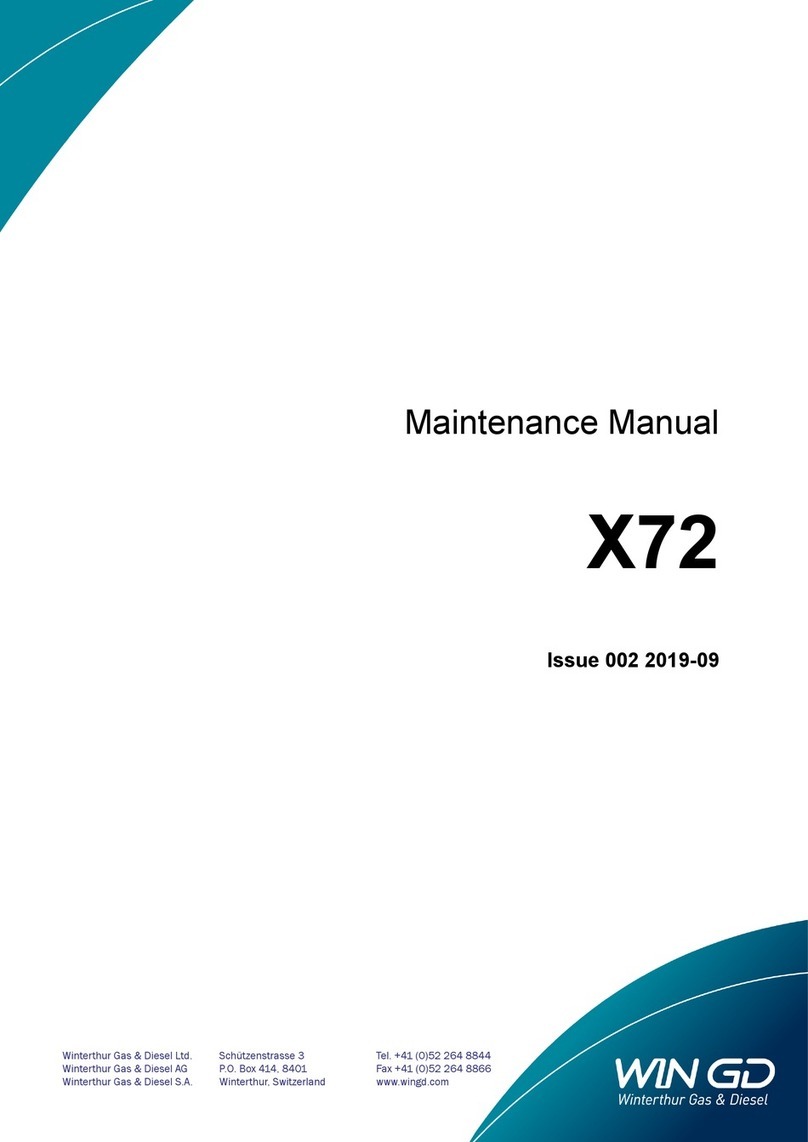
WinGD
WinGD X72 Maintenance manual

Oriental motor
Oriental motor BLE2 Series operating manual
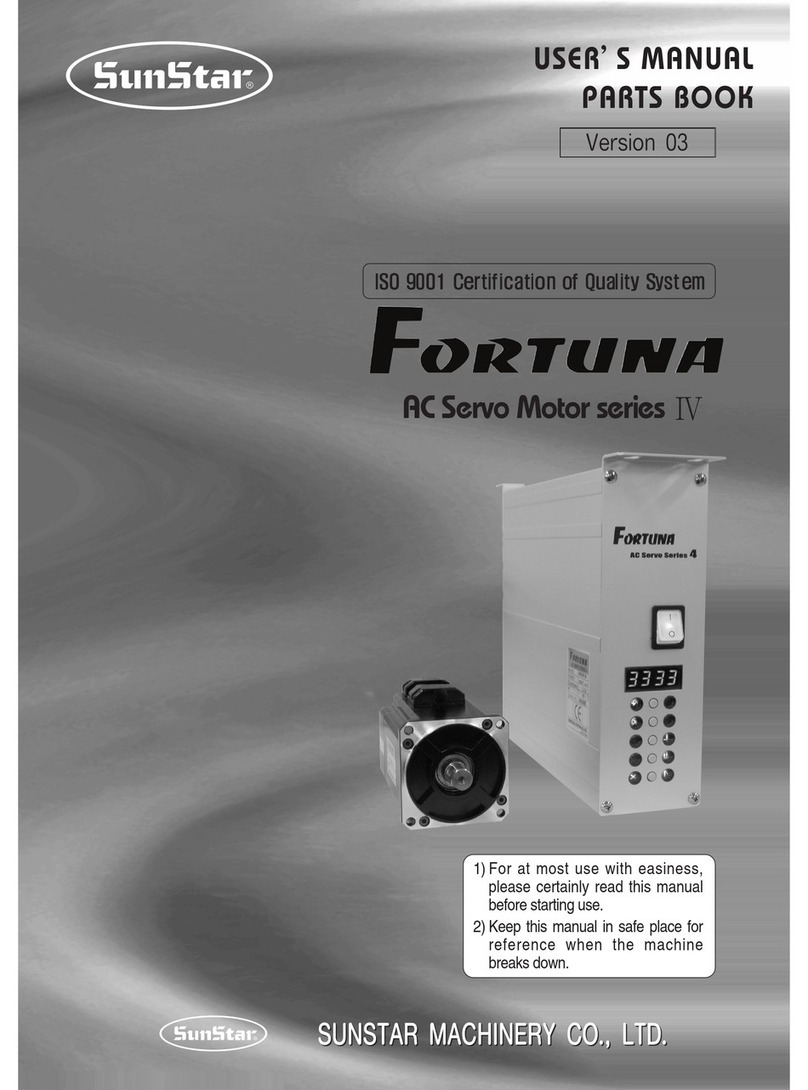
SunStar
SunStar Fortuna series user manual

ULPOWER
ULPOWER UL390i installation manual
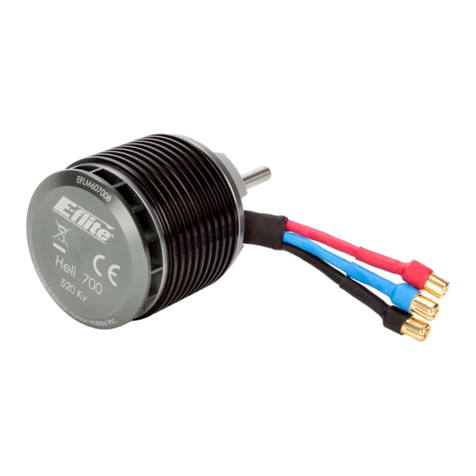
O.S. engine
O.S. engine O.S.MOTOR OMH-5830-490 Owner's instruction manual

